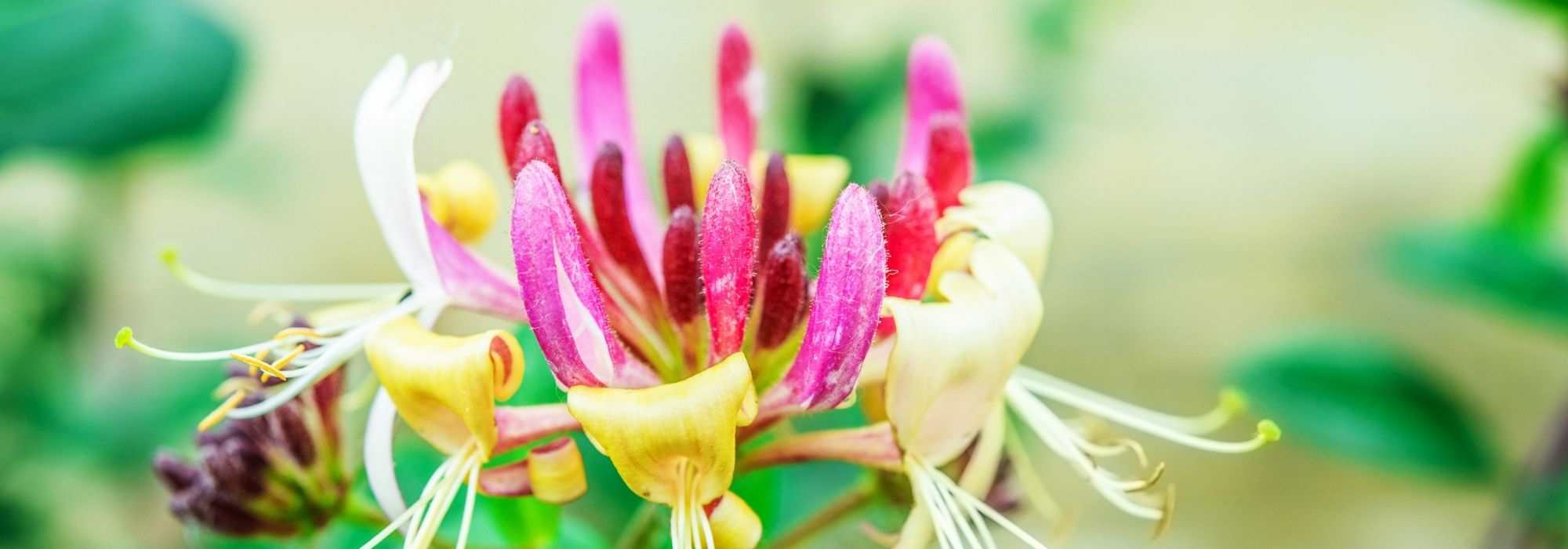
Honeysuckle: the reliable choices
Our selection of 7 climbing honeysuckles
Contents
Capable of reaching up to 10 metres depending on the species and cultivar, the Honeysuckle quickly covers surfaces and various types of supports: trellis, pergola, fencing, arch, post, etc. With its summer flowering renowned for its pleasant fragrance, the climbing Honeysuckle displays beautiful colours, ranging from cream white to vibrant red-pink. There are many varieties available, so we offer a selection of 7 climbing Honeysuckles, featuring magnificent blooms and delightful scents!
To learn more about its cultivation, check our advice sheet Honeysuckle: planting, pruning, and maintenance.
Lonicera similis var. delavayi
The Lonicera similis var delavayi is particularly robust. Its introduction to France was made by Abbé J-M Delavay for the Vilmorin company in 1896 upon its discovery in China. Fast-growing, it can reach up to 5 m in height and nearly the same in width! Moreover, this is an evergreen specimen, retaining its leaves in winter, which is an additional asset for this Delavay Honeysuckle. Flowering from late June to early August in pale shades (cream white and yellow), it offers us a generous floral display that is highly fragrant. You can find it companions with other climbing plants that flower earlier (Holboellia latifolia, Stauntonia hexaphylla) or decorative in autumn (Vitis coignetiae, Virginia Creeper) to enjoy a beautiful colourful screen for longer.
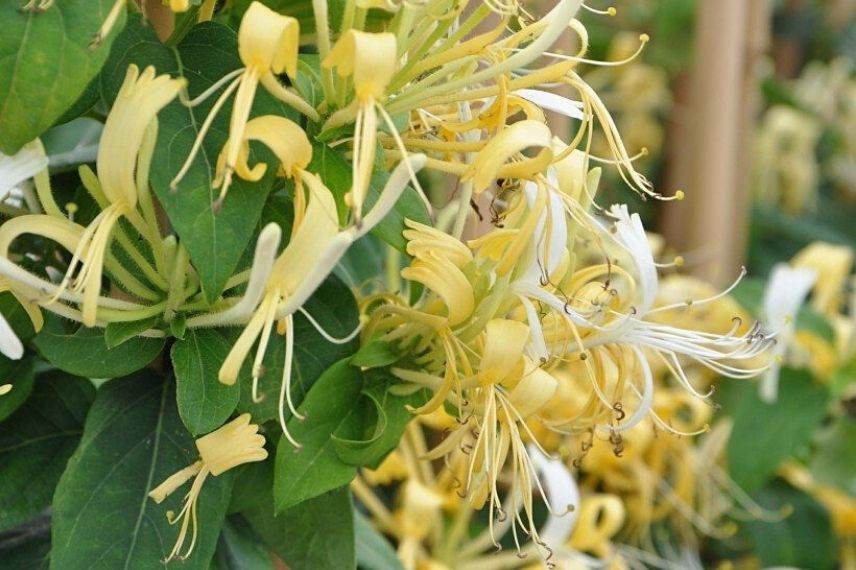
Lonicera similis var delavayi (photo Javoy Plantes)
Lonicera japonica 'Sinensis'
The Lonicera japonica ‘Sinensis’ stands out with its purple-tinted foliage! In spring, the young shoots are coloured red-bronze and the leaves emerge in purple-green. This foliage beautifully enhances the multicoloured flowering, white, yellow, and pink, present from June to September. Very vigorous, it can climb up to 5-6 m high and is perfect for covering a fence or a weathered wall. It can also be used as a groundcover plant. With excellent cold resistance, it adapts very well to regions with harsh winters. Requiring little maintenance, plant this Japanese Honeysuckle ‘Sinensis’ in a warm, but not scorching, location with its base in the shade within a hedge of shrubs flowering in different seasons: Viburnum, Forsythia, summer Ceanothus like the Ceanothus delilianus ‘Gloire de Versailles’, Butterfly tree, or Japanese Quince.
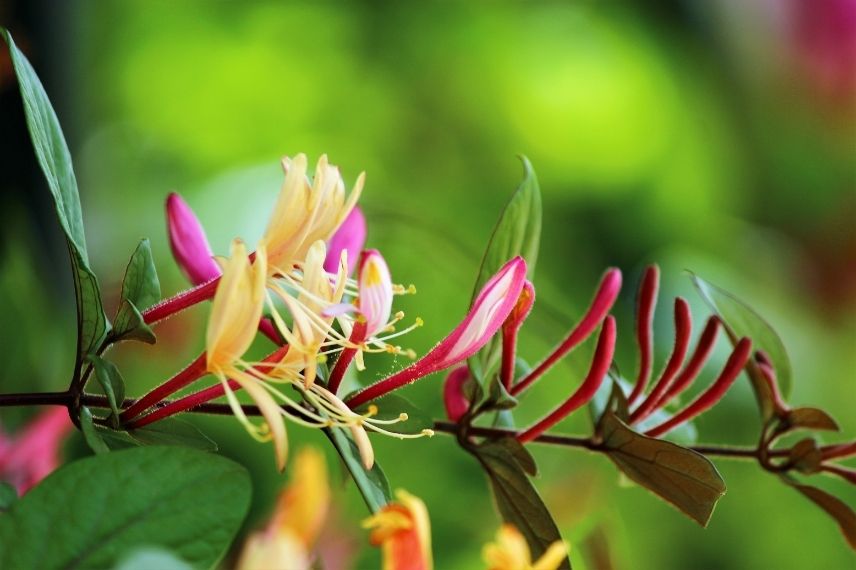
Lonicera japonica ‘Sinensis’ (photo pixabay)
Discover other Honeysuckle
View all →Available in 2 sizes
Available in 2 sizes
Available in 2 sizes
Available in 1 sizes
Available in 1 sizes
Available in 1 sizes
Available in 1 sizes
Available in 2 sizes
Available in 1 sizes
Available in 1 sizes
Lonicera tellmaniana
From May to July, Lonicera tellmaniana enchants us with its generous yellow-orange flowering, which is very fresh. Grouped in clusters, its trumpet-shaped flowers are large, reaching about 6 cm in length. Unfortunately, Tellman’s Honeysuckle is not fragrant. Nevertheless, it has been awarded by the Royal Horticultural Society in England. It has other assets! Cold resistance, large size, and vigorous growth, it can quickly cover large spaces, reaching up to 5 m in height. Moreover, when planted in full shade, it blooms just as abundantly as in partial shade, adding dynamism to the garden. Create a colourful scene and highlight its original and exotic hue by pairing it with a Coral Plant (Berberidopsis corallina) or a climbing Fuchsia like Fuchsia ‘Lady Boothby’.
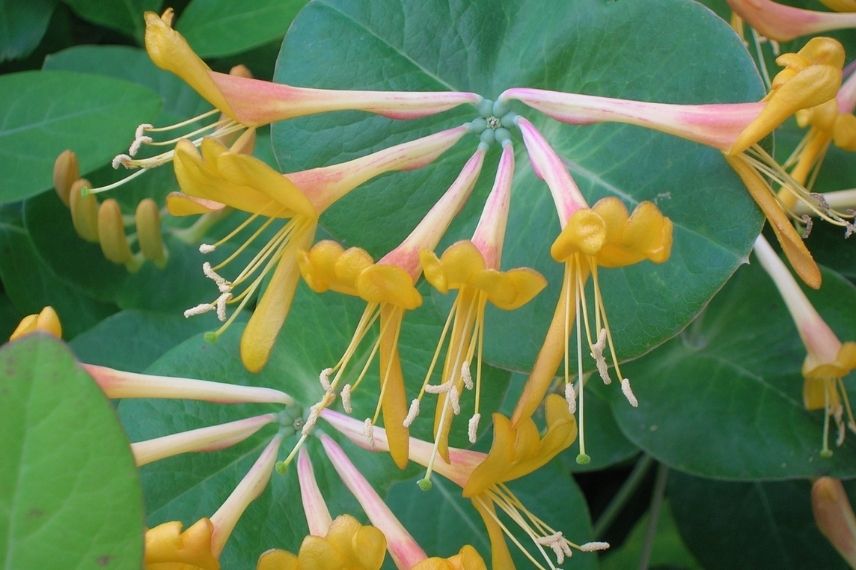
Lonicera tellmaniana
Read also
How to grow Honeysuckle in a pot?Lonicera heckrotii ‘American Beauty’
The Lonicera heckrotii ‘American Beauty’ is an impressive and exuberant variety with its numerous vibrant flowers. This climbing Honeysuckle blooms from early summer, in June until September, and produces large, 5 cm bright pink tubular flowers with open yellow-orange lips. Thanks to its excellent floribundity, this climber displays a profusion of warm flowers, covering its blue-green foliage. Additionally, its pleasantly fragrant flowers emit a powerful floral and spicy scent. It withstands negative temperatures down to about -20°C, but be aware that it will be deciduous or evergreen depending on your climate. In partial shade, this reasonably sized Honeysuckle (4 m high and 2 m wide) fits perfectly into gardens, accompanied by a Clematis viticella or a subtle Akebia.
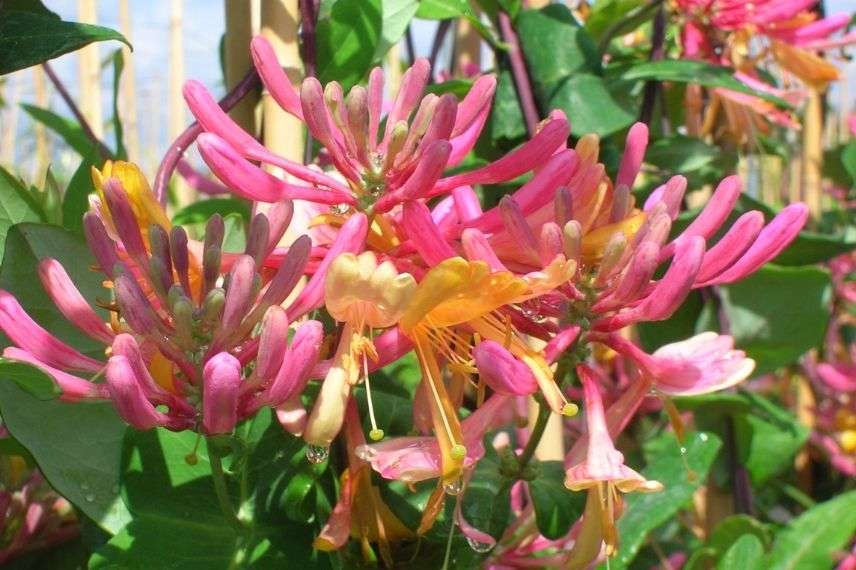
Lonicera heckrotii ‘American Beauty’
Lonicera japonica ‘Mint Crisp’
TheLonicera japonica ‘Mint Crisp’ is an essential variety! This honeysuckle features stunning variegated green and yellow foliage. From June to September, it bears fragrant flowers about 4 cm in size, initially cream white and gradually turning yellow. The combination of trumpet-shaped leaves and flowers gives it a lot of vibrancy. Following the flowering, small berries appear to adorn this climbing plant. Evergreen, it retains its foliage throughout winter. Bright, it is perfect for illuminating a shaded garden! This climbing plant is of medium size, reaching 3 m in height and 2 m in spread at ripeness. Train this very hardy Japanese honeysuckle against a wall alongside a climbing hydrangea.
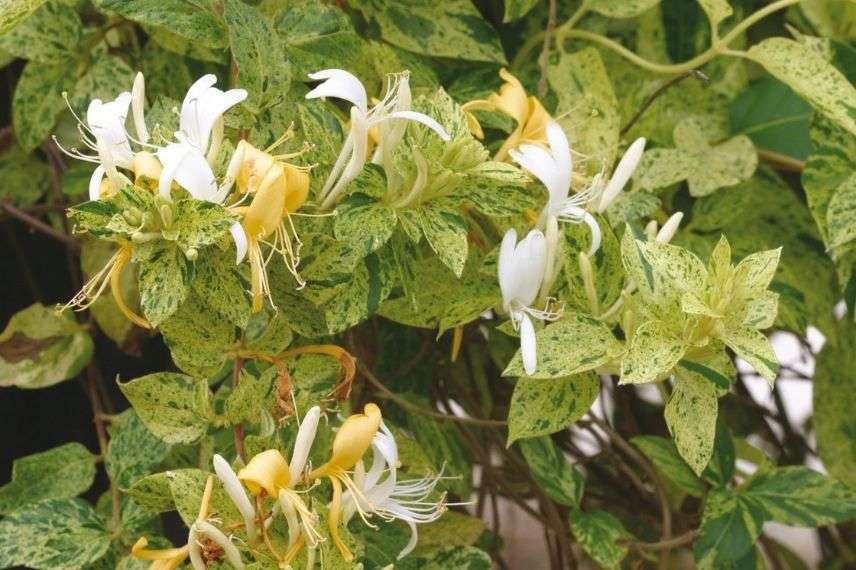
Lonicera japonica ‘Mint Crisp’
Lonicera japonica ‘Red World’
The Lonicera japonica ‘Red World’ produces an extraordinary and intense flowering. It blooms in summer, from June to August, covering itself with a multitude of flowers tinted with a delicate blend of deep pink-red and rosy white. Its flowers are smaller than those of the Japanese honeysuckle ‘Mint Crisp’ and measure only 2 cm, but they release a strong sweet fragrance! Its leaves are glossy, quite dark, with very pronounced red veins. This Japanese honeysuckle is vigorous, and its lianas can climb up to 6 metres high. Feel free to let it climb a large tree alongside other climbing honeysuckles, Russian vine (Fallopia aubertii) or Schizophragma hydrangeoides.
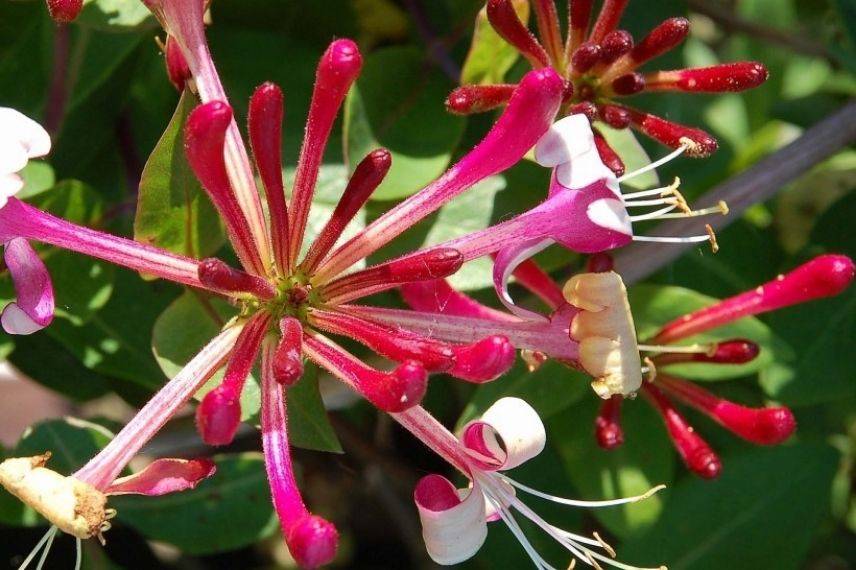
Lonicera japonica ‘Red World’
Lonicera caprifolium
Early species, Lonicera caprifolium reveals itself in spring with a creamy white to yellow and pink flowering. Depending on the climate, flowers appear from April-May to August-September. At the tips of the branches, its rounded grey-green leaves form a cup in which the inflorescences are inserted. Also known as Garden Honeysuckle or Common Honeysuckle and native to Europe, it is the most common of all and is highly fragrant, especially at night. In autumn, the fruits take the form of red berries consumed by birds. Plant this large deciduous Honeysuckle (6 to 8 m high when mature) on a support with other evergreen climbing plants to create a prolonged decorative effect: Ivy, Star Jasmine ‘Variegatum’ or Clematis armandii.
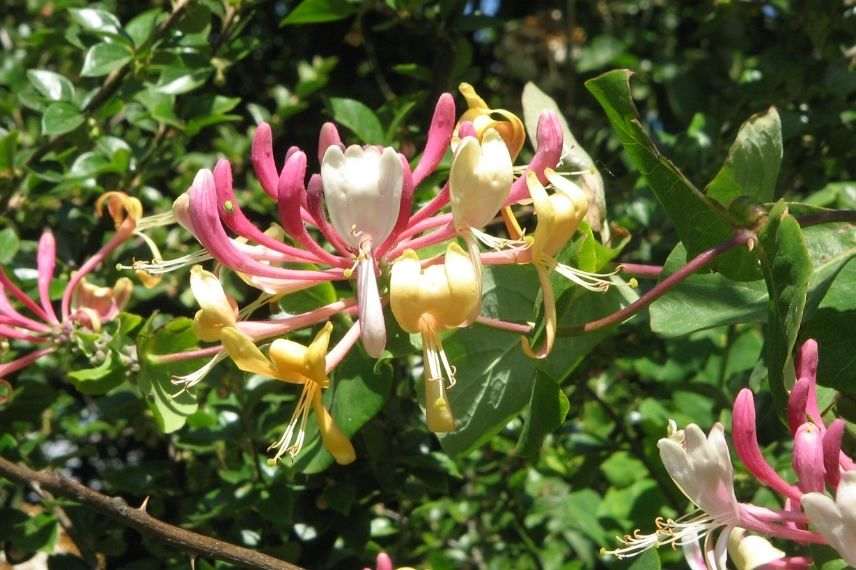
Lonicera caprifolium
For further reading
- Find our selection of the most fragrant honeysuckles.
- Also discover our complete article on Honeysuckle: planting, pruning and care.
- Subscribe!
- Contents
































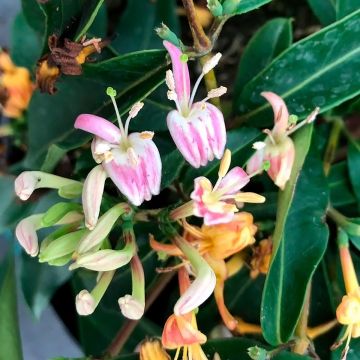

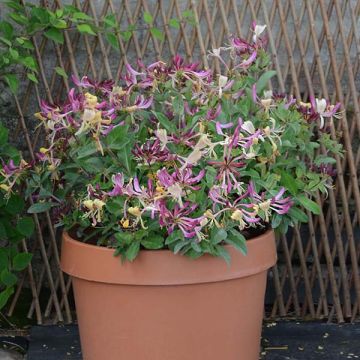

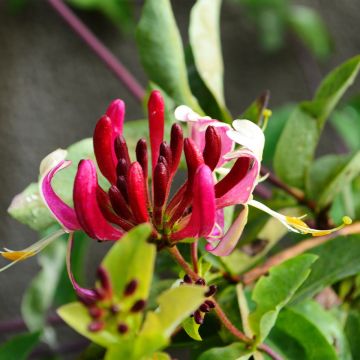
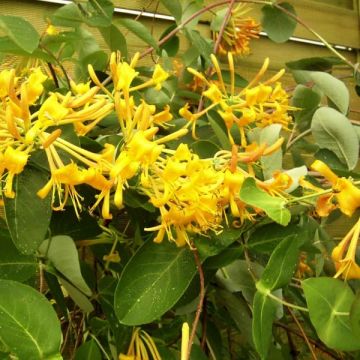
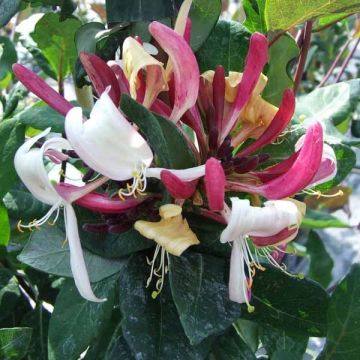


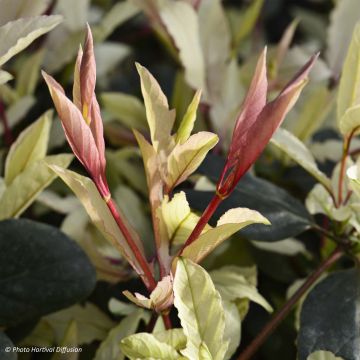
Comments